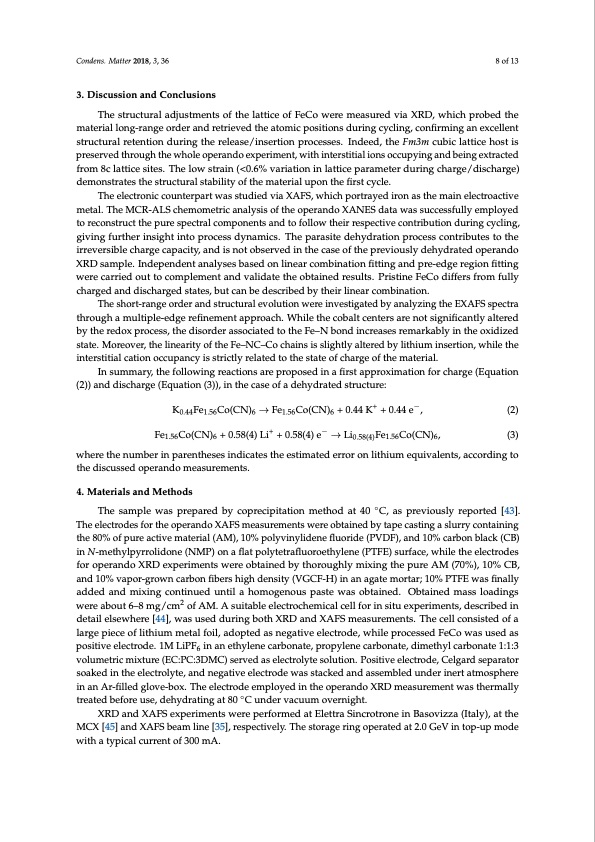
PDF Publication Title:
Text from PDF Page: 008
Condens. Matter 2018, 3, 36 8 of 13 3. Discussion and Conclusions The structural adjustments of the lattice of FeCo were measured via XRD, which probed the material long-range order and retrieved the atomic positions during cycling, confirming an excellent structural retention during the release/insertion processes. Indeed, the Fm3m cubic lattice host is preserved through the whole operando experiment, with interstitial ions occupying and being extracted from 8c lattice sites. The low strain (<0.6% variation in lattice parameter during charge/discharge) demonstrates the structural stability of the material upon the first cycle. The electronic counterpart was studied via XAFS, which portrayed iron as the main electroactive metal. The MCR-ALS chemometric analysis of the operando XANES data was successfully employed to reconstruct the pure spectral components and to follow their respective contribution during cycling, giving further insight into process dynamics. The parasite dehydration process contributes to the irreversible charge capacity, and is not observed in the case of the previously dehydrated operando XRD sample. Independent analyses based on linear combination fitting and pre-edge region fitting were carried out to complement and validate the obtained results. Pristine FeCo differs from fully charged and discharged states, but can be described by their linear combination. The short-range order and structural evolution were investigated by analyzing the EXAFS spectra through a multiple-edge refinement approach. While the cobalt centers are not significantly altered by the redox process, the disorder associated to the Fe–N bond increases remarkably in the oxidized state. Moreover, the linearity of the Fe–NC–Co chains is slightly altered by lithium insertion, while the interstitial cation occupancy is strictly related to the state of charge of the material. In summary, the following reactions are proposed in a first approximation for charge (Equation (2)) and discharge (Equation (3)), in the case of a dehydrated structure: K0.44Fe1.56Co(CN)6 → Fe1.56Co(CN)6 + 0.44 K+ + 0.44 e−, (2) Fe1.56Co(CN)6 + 0.58(4) Li+ + 0.58(4) e− → Li0.58(4)Fe1.56Co(CN)6, (3) where the number in parentheses indicates the estimated error on lithium equivalents, according to the discussed operando measurements. 4. Materials and Methods The sample was prepared by coprecipitation method at 40 ◦C, as previously reported [43]. The electrodes for the operando XAFS measurements were obtained by tape casting a slurry containing the 80% of pure active material (AM), 10% polyvinylidene fluoride (PVDF), and 10% carbon black (CB) in N-methylpyrrolidone (NMP) on a flat polytetrafluoroethylene (PTFE) surface, while the electrodes for operando XRD experiments were obtained by thoroughly mixing the pure AM (70%), 10% CB, and 10% vapor-grown carbon fibers high density (VGCF-H) in an agate mortar; 10% PTFE was finally added and mixing continued until a homogenous paste was obtained. Obtained mass loadings were about 6–8 mg/cm2 of AM. A suitable electrochemical cell for in situ experiments, described in detail elsewhere [44], was used during both XRD and XAFS measurements. The cell consisted of a large piece of lithium metal foil, adopted as negative electrode, while processed FeCo was used as positive electrode. 1M LiPF6 in an ethylene carbonate, propylene carbonate, dimethyl carbonate 1:1:3 volumetric mixture (EC:PC:3DMC) served as electrolyte solution. Positive electrode, Celgard separator soaked in the electrolyte, and negative electrode was stacked and assembled under inert atmosphere in an Ar-filled glove-box. The electrode employed in the operando XRD measurement was thermally treated before use, dehydrating at 80 ◦C under vacuum overnight. XRD and XAFS experiments were performed at Elettra Sincrotrone in Basovizza (Italy), at the MCX [45] and XAFS beam line [35], respectively. The storage ring operated at 2.0 GeV in top-up mode with a typical current of 300 mA.PDF Image | XAFS and XRD Study of a Prussian Blue Analogue Cathode Iron Hexacyanocobaltate

PDF Search Title:
XAFS and XRD Study of a Prussian Blue Analogue Cathode Iron HexacyanocobaltateOriginal File Name Searched:
condensedmatter-03-00036.pdfDIY PDF Search: Google It | Yahoo | Bing
Sulfur Deposition on Carbon Nanofibers using Supercritical CO2 Sulfur Deposition on Carbon Nanofibers using Supercritical CO2. Gamma sulfur also known as mother of pearl sulfur and nacreous sulfur... More Info
CO2 Organic Rankine Cycle Experimenter Platform The supercritical CO2 phase change system is both a heat pump and organic rankine cycle which can be used for those purposes and as a supercritical extractor for advanced subcritical and supercritical extraction technology. Uses include producing nanoparticles, precious metal CO2 extraction, lithium battery recycling, and other applications... More Info
| CONTACT TEL: 608-238-6001 Email: greg@infinityturbine.com | RSS | AMP |